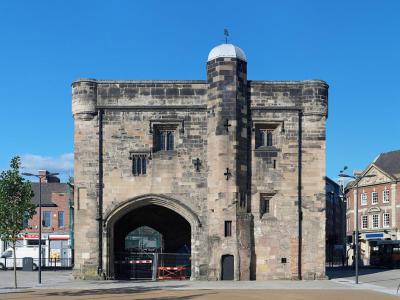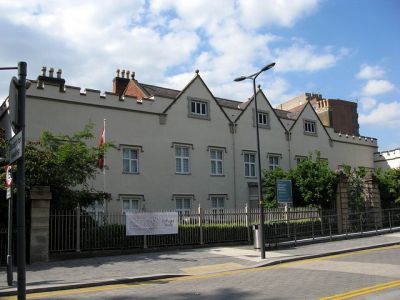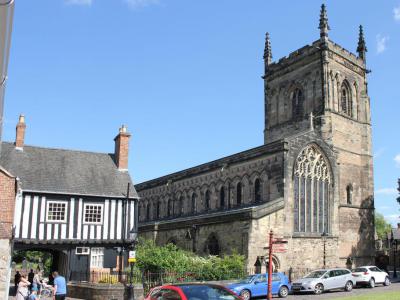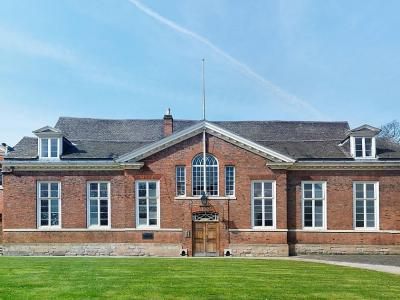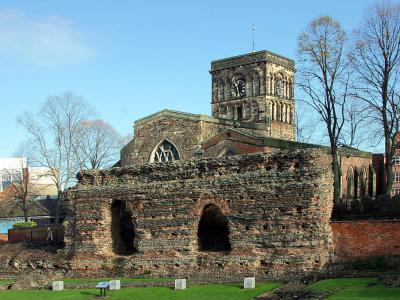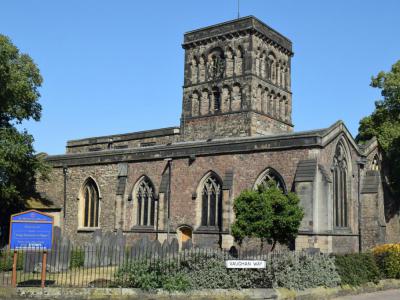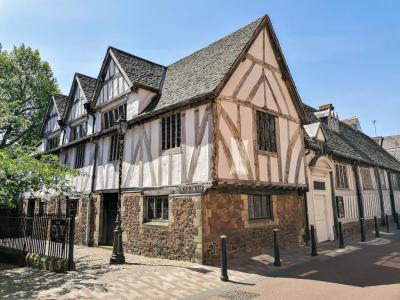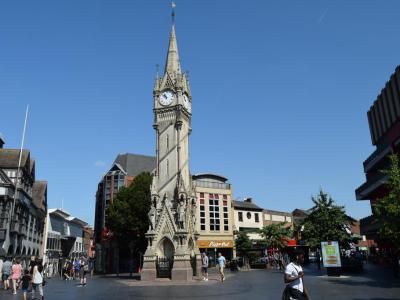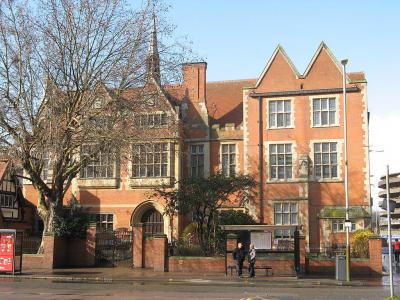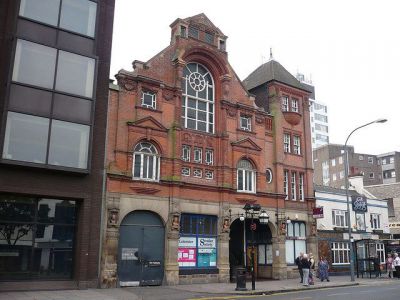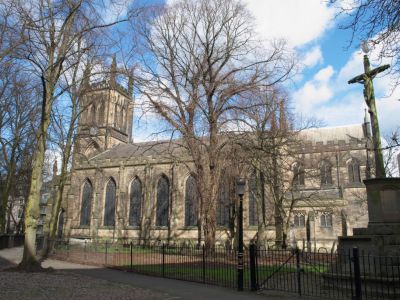Historical Buildings (Self Guided), Leicester
Leicester, a city in England's East Midlands, has a storied past that is vividly presented in its historical buildings. Valuable architectural monuments, they are the city's pride and as such enjoy special protection by the government.
Among such, Magazine Gateway stands as a testament to the city's medieval legacy. Originally part of its defensive walls, this structure now serves as a striking landmark.
Passing through this gateway you will find yourself at the Newarke Houses Museum, showcasing Leicester's architectural evolution along with insights into its daily life from medieval times to the present.
The Church of Mary de Castro is another noteworthy location. With its Norman architecture and historical significance, it encapsulates centuries of Leicester's yesteryear.
Leicester Castle, designed as part of the town's fortification system in the aftermath of the Norman Conquest, it then served as a royal residence and courthouse, witnessing many momentous events such as the English Civil War.
The Jewry Wall Museum showcases Leicester's Roman period, featuring remnants of Roman baths and an extensive archaeological collection.
Saint Nicholas's Church and The Guildhall are emblematic of Leicester's religious and civic heritage, respectively. The former is the oldest place of worship in the city, while the latter is said to have seen William Shakespeare himself live on stage.
The Haymarket Memorial Clock Tower, Clarence House, Secular Hall, and Saint George's Church further enrich Leicester's architectural landscape, each contributing to the city's unique character and history.
Collectively, these sites are like a window into Leicester's past, looking through which you can feel as if taking a time journey. So, why not embark on this historical trip now and discover the stories etched within the walls of these iconic landmarks? Your Leicester's history adventure awaits.
Among such, Magazine Gateway stands as a testament to the city's medieval legacy. Originally part of its defensive walls, this structure now serves as a striking landmark.
Passing through this gateway you will find yourself at the Newarke Houses Museum, showcasing Leicester's architectural evolution along with insights into its daily life from medieval times to the present.
The Church of Mary de Castro is another noteworthy location. With its Norman architecture and historical significance, it encapsulates centuries of Leicester's yesteryear.
Leicester Castle, designed as part of the town's fortification system in the aftermath of the Norman Conquest, it then served as a royal residence and courthouse, witnessing many momentous events such as the English Civil War.
The Jewry Wall Museum showcases Leicester's Roman period, featuring remnants of Roman baths and an extensive archaeological collection.
Saint Nicholas's Church and The Guildhall are emblematic of Leicester's religious and civic heritage, respectively. The former is the oldest place of worship in the city, while the latter is said to have seen William Shakespeare himself live on stage.
The Haymarket Memorial Clock Tower, Clarence House, Secular Hall, and Saint George's Church further enrich Leicester's architectural landscape, each contributing to the city's unique character and history.
Collectively, these sites are like a window into Leicester's past, looking through which you can feel as if taking a time journey. So, why not embark on this historical trip now and discover the stories etched within the walls of these iconic landmarks? Your Leicester's history adventure awaits.
How it works: Download the app "GPSmyCity: Walks in 1K+ Cities" from Apple App Store or Google Play Store to your mobile phone or tablet. The app turns your mobile device into a personal tour guide and its built-in GPS navigation functions guide you from one tour stop to next. The app works offline, so no data plan is needed when traveling abroad.
Historical Buildings Map
Guide Name: Historical Buildings
Guide Location: England » Leicester (See other walking tours in Leicester)
Guide Type: Self-guided Walking Tour (Sightseeing)
# of Attractions: 11
Tour Duration: 2 Hour(s)
Travel Distance: 2.6 Km or 1.6 Miles
Author: Ella
Sight(s) Featured in This Guide:
Guide Location: England » Leicester (See other walking tours in Leicester)
Guide Type: Self-guided Walking Tour (Sightseeing)
# of Attractions: 11
Tour Duration: 2 Hour(s)
Travel Distance: 2.6 Km or 1.6 Miles
Author: Ella
Sight(s) Featured in This Guide:
- Magazine Gateway
- Newarke Houses
- Church of Mary de Castro
- Leicester Castle and Castle Gardens
- Jewry Wall Museum
- St. Nicholas' Church
- The Guildhall
- Haymarket Memorial Clock Tower
- Clarence House
- Secular Hall
- St. George's Church
1) Magazine Gateway
The Magazine Gateway, built in 1410, is one of Leicester’s most notable landmarks. Originally, it served as a ceremonial entrance to the Castle of Leicester, though it never had doors. Designed to impress visitors, it also provided access to the prestigious Newark District-a sought-after residential area where inhabitants were exempt from taxes.
The gateway’s primary function was to create a grand entrance into the religious collegiate precinct of The Newarke. This area had been significantly developed in the 14th century. In 1330, Henry, the 3rd Earl of Lancaster, founded Trinity Hospital along the castle’s southern wall. His son, later the Duke of Lancaster, further elevated the district’s status by establishing the Collegiate Church of the Annunciation of St. Mary, which housed a revered relic-said to be a thorn from Christ’s Crown of Thorns.
Constructed shortly after 1400, the Gateway was completed alongside substantial walls enclosing the college precinct. By 1967, however, the James Went Building had been constructed over part of the site, and photographs suggest that some sections of the medieval walls remained standing at heights of up to 3 meters (9.8 feet) until that time.
The 1960s inner ring road development left the Magazine Gateway isolated, with major roads running on both sides and only accessible via pedestrian underpasses. In 1969, it was repurposed as a museum for the Royal Leicestershire Regiment, a role it fulfilled until 1996. Repairs and limited accessibility within the three-story structure eventually led to the museum’s relocation to the upper floor of the Newarke Houses Museum.
By 2007, efforts were made to better integrate this Grade I listed medieval building into the urban landscape. The underpass was filled in, allowing the street level on the west side to align with the gateway. The road was rerouted entirely to the east, and the western area was pedestrianized, reconnecting the Gateway with The Newarke. This transformation also created a new open space for students of De Montfort University, near its Business and Law School.
The gateway’s primary function was to create a grand entrance into the religious collegiate precinct of The Newarke. This area had been significantly developed in the 14th century. In 1330, Henry, the 3rd Earl of Lancaster, founded Trinity Hospital along the castle’s southern wall. His son, later the Duke of Lancaster, further elevated the district’s status by establishing the Collegiate Church of the Annunciation of St. Mary, which housed a revered relic-said to be a thorn from Christ’s Crown of Thorns.
Constructed shortly after 1400, the Gateway was completed alongside substantial walls enclosing the college precinct. By 1967, however, the James Went Building had been constructed over part of the site, and photographs suggest that some sections of the medieval walls remained standing at heights of up to 3 meters (9.8 feet) until that time.
The 1960s inner ring road development left the Magazine Gateway isolated, with major roads running on both sides and only accessible via pedestrian underpasses. In 1969, it was repurposed as a museum for the Royal Leicestershire Regiment, a role it fulfilled until 1996. Repairs and limited accessibility within the three-story structure eventually led to the museum’s relocation to the upper floor of the Newarke Houses Museum.
By 2007, efforts were made to better integrate this Grade I listed medieval building into the urban landscape. The underpass was filled in, allowing the street level on the west side to align with the gateway. The road was rerouted entirely to the east, and the western area was pedestrianized, reconnecting the Gateway with The Newarke. This transformation also created a new open space for students of De Montfort University, near its Business and Law School.
2) Newarke Houses
Located next to Leicester Castle in the historic heart of the city, the Newarke Houses Museum consists of two distinct yet complementary buildings that provide insight into Leicester’s evolution. These two structures-Wyggeston’s Chantry House and Skeffington House-originate from different periods and styles but together help illustrate the city’s architectural and social history.
Wyggeston’s Chantry House, built around 1511, is Leicester’s only surviving Elizabethan-era house. Skeffington House, from the 17th century, was home to the Skeffington family. Both played roles in the 1645 Siege of Leicester, with Cromwell’s troops modifying the garden wall for defense. After serving as a residence, school, and military quarters, they became a museum in 1953 for Queen Elizabeth II’s coronation.
The Newarke Houses Museum presents a wide-ranging collection covering over 300 years of Leicester’s post-medieval and modern history. One of the museum’s highlights is its exhibit on Daniel Lambert, an 18th-century Leicester resident famed for being Britain’s largest man at over 50 stone (320 kg). His possessions, including clothing and furniture, are on display.
A standout feature of the museum is the recreation of a 1950s Leicester street, modeled after Wharf Street, complete with shopfronts and period details. Another notable exhibit showcases toys from Tudor times to the present, illustrating childhood experiences across centuries.
The museum also emphasizes Leicester’s industrial heritage, particularly its hosiery and textile industry, with exhibits on major clothing firms such as Corah’s and Wolsey.
One of the museum’s integral sections is dedicated to the Royal Leicestershire Regiment, containing an extensive collection of military memorabilia, medals, and records. Visitors can explore accounts of Leicester residents’ contributions during wartime through digital archives accessible on-site.
Surrounding the museum are carefully maintained gardens, divided into distinct areas. One section features a Victorian-era collection of exotic trees and plants, while another follows a medieval-style design with intricate box hedge patterns. The garden wall, still bearing 17th-century gun loops from the English Civil War, serves as a tangible link to Leicester’s turbulent past.
Today, the Newarke Houses Museum serves as a key cultural landmark within De Montfort University’s campus, offering visitors a rich and immersive journey through Leicester’s history.
Wyggeston’s Chantry House, built around 1511, is Leicester’s only surviving Elizabethan-era house. Skeffington House, from the 17th century, was home to the Skeffington family. Both played roles in the 1645 Siege of Leicester, with Cromwell’s troops modifying the garden wall for defense. After serving as a residence, school, and military quarters, they became a museum in 1953 for Queen Elizabeth II’s coronation.
The Newarke Houses Museum presents a wide-ranging collection covering over 300 years of Leicester’s post-medieval and modern history. One of the museum’s highlights is its exhibit on Daniel Lambert, an 18th-century Leicester resident famed for being Britain’s largest man at over 50 stone (320 kg). His possessions, including clothing and furniture, are on display.
A standout feature of the museum is the recreation of a 1950s Leicester street, modeled after Wharf Street, complete with shopfronts and period details. Another notable exhibit showcases toys from Tudor times to the present, illustrating childhood experiences across centuries.
The museum also emphasizes Leicester’s industrial heritage, particularly its hosiery and textile industry, with exhibits on major clothing firms such as Corah’s and Wolsey.
One of the museum’s integral sections is dedicated to the Royal Leicestershire Regiment, containing an extensive collection of military memorabilia, medals, and records. Visitors can explore accounts of Leicester residents’ contributions during wartime through digital archives accessible on-site.
Surrounding the museum are carefully maintained gardens, divided into distinct areas. One section features a Victorian-era collection of exotic trees and plants, while another follows a medieval-style design with intricate box hedge patterns. The garden wall, still bearing 17th-century gun loops from the English Civil War, serves as a tangible link to Leicester’s turbulent past.
Today, the Newarke Houses Museum serves as a key cultural landmark within De Montfort University’s campus, offering visitors a rich and immersive journey through Leicester’s history.
3) Church of Mary de Castro
The Church of Saint Mary de Castro-literally, "Saint Mary of the Castle"-is a historic parish church standing near Leicester Castle. Founded in 1107, its origins trace back to King Henry I, who seized the castle and surrounding lands from a rebellious noble and granted them to Robert de Beaumont. Some legends, however, suggest that a Saxon church dedicated to Saint Mary predated the Norman structure. The church functioned as a collegiate institution until 1548 when Henry VIII dissolved its college.
The earliest version of the church had no aisles, but a major expansion in the 1160s introduced a north aisle, additional doorways, and an extended chancel. The church is well known for its Norman zigzag-decorated doorways, particularly the Sedilia and Piscina, which architectural historian Nikolaus Pevsner praised as the "finest piece of Norman decoration in the county." A 13th-century renovation saw the widening of the south aisle, making it even broader than the nave, and the addition of the large east window with intricate tracery completed around 1300.
The church tower, an architectural afterthought, was built inside the south aisle. It features decorated pinnacles and a quatrefoil frieze, culminating in a needlelike spire. The spire, originally from the 14th century, was rebuilt in 1783 but suffered structural failure in 2013, with six-metre cracks detected in four of its faces. Deemed at risk of collapse, the spire was demolished in 2014, and despite extensive fundraising, there are insufficient funds for its reconstruction.
Inside, the church houses a three-manual pipe organ installed in 1860 by Forster and Andrews. Over time, it underwent modifications by Joshua Porritt (1880) and R. J. Winn (1960). The organ's specification is recorded in the National Pipe Organ Register.
Despite the loss of its iconic spire, Saint Mary de Castro remains an important historic and spiritual landmark in Leicester, reflecting nearly a millennium of architectural evolution and local history.
The earliest version of the church had no aisles, but a major expansion in the 1160s introduced a north aisle, additional doorways, and an extended chancel. The church is well known for its Norman zigzag-decorated doorways, particularly the Sedilia and Piscina, which architectural historian Nikolaus Pevsner praised as the "finest piece of Norman decoration in the county." A 13th-century renovation saw the widening of the south aisle, making it even broader than the nave, and the addition of the large east window with intricate tracery completed around 1300.
The church tower, an architectural afterthought, was built inside the south aisle. It features decorated pinnacles and a quatrefoil frieze, culminating in a needlelike spire. The spire, originally from the 14th century, was rebuilt in 1783 but suffered structural failure in 2013, with six-metre cracks detected in four of its faces. Deemed at risk of collapse, the spire was demolished in 2014, and despite extensive fundraising, there are insufficient funds for its reconstruction.
Inside, the church houses a three-manual pipe organ installed in 1860 by Forster and Andrews. Over time, it underwent modifications by Joshua Porritt (1880) and R. J. Winn (1960). The organ's specification is recorded in the National Pipe Organ Register.
Despite the loss of its iconic spire, Saint Mary de Castro remains an important historic and spiritual landmark in Leicester, reflecting nearly a millennium of architectural evolution and local history.
4) Leicester Castle and Castle Gardens
Leicester Castle, a historic stronghold in the heart of Leicester, stands as a reminder of the city's medieval past. Located west of the city center, between Saint Nicholas Circle and De Montfort University, the castle complex features a large motte, the Great Hall, the ruined Turret Gateway, and the Church of Saint Mary de Castro. Once a formidable defensive structure, the castle was built around 1070, shortly after the Norman Conquest, incorporating parts of the old Roman town walls.
For centuries, Leicester Castle was home to the Earls of Leicester, passing from the House of Beaumont to Montfort and later Lancaster. It briefly served as a royal residence under Henry IV to Edward IV but declined by the 15th century, with the Great Hall becoming a courthouse. In 1426, it hosted the Parliament of Bats, where attendees carried clubs instead of swords due to a weapons ban.
Leicester Castle faced conflict during the 1173 rebellion, when Leicester was besieged and burned, and again in the 1640s Civil War, with gun loops added for defense. Now a scheduled monument, its Great Hall features an 18th-century Queen Anne-style façade.
Adjacent to the castle lies Castle Gardens, a peaceful green space by the Grand Union Canal. Situated in the former medieval city, this tranquil park offers visitors a chance to explore Leicester’s rich heritage while enjoying nature. The motte, accessible via footpaths and steps, provides panoramic views, while the cobbled paths lead visitors toward the Turret Gateway and Saint Mary de Castro Church, which once hosted the wedding of Geoffrey Chaucer and the knighting of the young Henry VI.
Castle Gardens is a haven of biodiversity within the city. Its well-maintained flowerbeds, mature trees, and natural vegetation support pollinating insects, while the ornamental pond provides a habitat for frogs and smooth newts. The surrounding historic buildings and nearby waterways also make the area an ideal roosting and foraging site for bats. Whether strolling through its seasonal plantings or resting on a bench overlooking the canal, visitors to Castle Gardens can enjoy a serene retreat within Leicester’s historic core.
For centuries, Leicester Castle was home to the Earls of Leicester, passing from the House of Beaumont to Montfort and later Lancaster. It briefly served as a royal residence under Henry IV to Edward IV but declined by the 15th century, with the Great Hall becoming a courthouse. In 1426, it hosted the Parliament of Bats, where attendees carried clubs instead of swords due to a weapons ban.
Leicester Castle faced conflict during the 1173 rebellion, when Leicester was besieged and burned, and again in the 1640s Civil War, with gun loops added for defense. Now a scheduled monument, its Great Hall features an 18th-century Queen Anne-style façade.
Adjacent to the castle lies Castle Gardens, a peaceful green space by the Grand Union Canal. Situated in the former medieval city, this tranquil park offers visitors a chance to explore Leicester’s rich heritage while enjoying nature. The motte, accessible via footpaths and steps, provides panoramic views, while the cobbled paths lead visitors toward the Turret Gateway and Saint Mary de Castro Church, which once hosted the wedding of Geoffrey Chaucer and the knighting of the young Henry VI.
Castle Gardens is a haven of biodiversity within the city. Its well-maintained flowerbeds, mature trees, and natural vegetation support pollinating insects, while the ornamental pond provides a habitat for frogs and smooth newts. The surrounding historic buildings and nearby waterways also make the area an ideal roosting and foraging site for bats. Whether strolling through its seasonal plantings or resting on a bench overlooking the canal, visitors to Castle Gardens can enjoy a serene retreat within Leicester’s historic core.
5) Jewry Wall Museum
The Jewry Wall is thought to be the last remaining section of the public baths of Roman Leicester, standing alongside the baths' foundations, which are displayed in front of it. Nearly 2,000 years old, the wall is a rare and significant example of Roman construction. It is the second-largest surviving piece of Roman civil architecture in Britain and is believed to have once separated the gymnasium from the cold room.
The baths' remains were excavated in the 1930s by Dame Kathleen Kenyon and date back to approximately 160 A.D. Adjacent to the ruins is the Jewry Wall Museum, home to an impressive collection of Roman mosaics and wall plaster from the local area. Despite its name, the wall is unlikely to have any connection to Leicester’s Jewish community, which remained small and was expelled from the town by Simon de Montfort in 1231.
Constructed in the 1960s, the Jewry Wall Museum faces the ruins and was originally housed in a building shared with Vaughan College. It displayed artifacts from Leicester’s Iron Age, Roman, and medieval past. When Vaughan College ceased operations in 2013, the city council acquired the entire site, initiating plans for its expansion and enhancement.
Designed by Trevor Dannatt and completed in 1962, the museum building is Grade II listed. Until 2013, it was situated beneath Vaughan College, which was part of Leicester University’s Institute for Lifelong Learning. Today, the museum is managed by Leicester City Council and offers free admission.
The baths' remains were excavated in the 1930s by Dame Kathleen Kenyon and date back to approximately 160 A.D. Adjacent to the ruins is the Jewry Wall Museum, home to an impressive collection of Roman mosaics and wall plaster from the local area. Despite its name, the wall is unlikely to have any connection to Leicester’s Jewish community, which remained small and was expelled from the town by Simon de Montfort in 1231.
Constructed in the 1960s, the Jewry Wall Museum faces the ruins and was originally housed in a building shared with Vaughan College. It displayed artifacts from Leicester’s Iron Age, Roman, and medieval past. When Vaughan College ceased operations in 2013, the city council acquired the entire site, initiating plans for its expansion and enhancement.
Designed by Trevor Dannatt and completed in 1962, the museum building is Grade II listed. Until 2013, it was situated beneath Vaughan College, which was part of Leicester University’s Institute for Lifelong Learning. Today, the museum is managed by Leicester City Council and offers free admission.
6) St. Nicholas' Church
Saint Nicholas' Church is the oldest surviving place of worship in Leicester, with origins dating back to 880 A.D. Located next to the Jewry Wall, the remnants of Leicester’s Roman baths, the church has long stood as a historical landmark with possible Roman-era foundations. Its Norman tower adds to its architectural significance.
By 1825, the church had fallen into serious disrepair, and plans were made for its demolition. However, financial constraints prevented its replacement, leading instead to an extensive renovation between 1875 and 1884, including the addition of a new north aisle. Restoration efforts continued into the 20th century, incorporating elements such as a 15th-century octagonal font from the former Church of Saint Michael the Greater in Stamford.
In the 1950s, the church’s focus shifted toward serving local university students, eventually becoming the official church of the University of Leicester despite being some distance from the campus. More recently, Saint Nicholas has embraced an Inclusive Church mission, actively welcoming worshippers from diverse sexualities, identities, abilities, and socioeconomic backgrounds. Reflecting its strong LGBTQ+ community, the church prominently displays pride flags.
Saint Nicholas is also home to a unique 1890 organ by local builder J. Porritt, incorporating pipework from an earlier instrument dating to the 1830s. Its three historic bells, cast in 1617, 1656, and 1710, were removed in 1949 due to the tower’s structural weakness and later reinstalled in 2002. They were rung in celebration of Queen Elizabeth II’s Jubilee Visit to Leicester that year.
Standing just outside the inner ring road, Saint Nicholas' Church continues to blend its rich history with a modern, inclusive vision, making it an enduring part of Leicester’s spiritual and cultural fabric.
By 1825, the church had fallen into serious disrepair, and plans were made for its demolition. However, financial constraints prevented its replacement, leading instead to an extensive renovation between 1875 and 1884, including the addition of a new north aisle. Restoration efforts continued into the 20th century, incorporating elements such as a 15th-century octagonal font from the former Church of Saint Michael the Greater in Stamford.
In the 1950s, the church’s focus shifted toward serving local university students, eventually becoming the official church of the University of Leicester despite being some distance from the campus. More recently, Saint Nicholas has embraced an Inclusive Church mission, actively welcoming worshippers from diverse sexualities, identities, abilities, and socioeconomic backgrounds. Reflecting its strong LGBTQ+ community, the church prominently displays pride flags.
Saint Nicholas is also home to a unique 1890 organ by local builder J. Porritt, incorporating pipework from an earlier instrument dating to the 1830s. Its three historic bells, cast in 1617, 1656, and 1710, were removed in 1949 due to the tower’s structural weakness and later reinstalled in 2002. They were rung in celebration of Queen Elizabeth II’s Jubilee Visit to Leicester that year.
Standing just outside the inner ring road, Saint Nicholas' Church continues to blend its rich history with a modern, inclusive vision, making it an enduring part of Leicester’s spiritual and cultural fabric.
7) The Guildhall (must see)
The Guildhall in Leicester is one of the city's most treasured historic buildings, with origins dating back to around 1390. A remarkable example of timber-framed architecture, it has served various civic and cultural functions over the centuries. Originally built as a meeting place for the Guild of Corpus Christi, a powerful group of local businessmen and gentry, the Guildhall later became the town hall of Leicester, a role it retained until a new town hall was commissioned in 1876.
Located in the old walled city, on what is now known as Guildhall Lane, the building has witnessed many pivotal moments in English history. During the English Civil War, the Guildhall was looted by Royalist troops, and it was here that the city's leaders discussed the Royalist ultimatum. When the Spanish Armada was defeated in 1588, Leicester’s celebrations were held within its walls. The building also played a role in Leicester’s legal and policing history, serving as a courtroom, jail, and the city's first police station.
The Guildhall has long been a cultural and intellectual hub. In 1632, it became the city’s library, making it one of the oldest public libraries in England. The 16th century saw a growing enthusiasm for theatre, and it is believed that William Shakespeare himself performed at the Guildhall. Today, it continues to be a dynamic performance venue, hosting concerts, plays, comedy gigs, and exhibitions.
Now a museum, Leicester Guildhall offers visitors an immersive journey into the city’s medieval past. Its galleries explore the history of Leicester, while the Mayor’s Parlour showcases late-medieval stained glass. Visitors can also step inside the original jail cells, which house unsettling relics of the past, including historical torture devices. The Guildhall is also reputed to be haunted, with five resident ghosts said to linger within its walls-a claim that has drawn paranormal investigations, including TV’s 'Most Haunted.'
Located in the old walled city, on what is now known as Guildhall Lane, the building has witnessed many pivotal moments in English history. During the English Civil War, the Guildhall was looted by Royalist troops, and it was here that the city's leaders discussed the Royalist ultimatum. When the Spanish Armada was defeated in 1588, Leicester’s celebrations were held within its walls. The building also played a role in Leicester’s legal and policing history, serving as a courtroom, jail, and the city's first police station.
The Guildhall has long been a cultural and intellectual hub. In 1632, it became the city’s library, making it one of the oldest public libraries in England. The 16th century saw a growing enthusiasm for theatre, and it is believed that William Shakespeare himself performed at the Guildhall. Today, it continues to be a dynamic performance venue, hosting concerts, plays, comedy gigs, and exhibitions.
Now a museum, Leicester Guildhall offers visitors an immersive journey into the city’s medieval past. Its galleries explore the history of Leicester, while the Mayor’s Parlour showcases late-medieval stained glass. Visitors can also step inside the original jail cells, which house unsettling relics of the past, including historical torture devices. The Guildhall is also reputed to be haunted, with five resident ghosts said to linger within its walls-a claim that has drawn paranormal investigations, including TV’s 'Most Haunted.'
8) Haymarket Memorial Clock Tower
The Haymarket Memorial Clock Tower is one of Leicester’s most recognizable landmarks and a favored meeting spot. Positioned near the city center within the ring road, it marks the convergence of five key streets: Gallowtree Gate, Humberstone Gate, Belgrave Gate, Church Gate, and Eastgates, with Cheapside also nearby. For generations, it has been the go-to rendezvous point in the heart of the city.
Before the Clock Tower’s construction, the site housed an Assembly Room built in 1750, later repurposed into shops in 1805. Over time, it gained a reputation as "the Haymarket Obstruction," prompting local property owners to campaign for its removal. The building was demolished in 1862, though the hay market remained in place until it was eventually moved to Humberstone Gate.
Clearing the site left a broad open space that became increasingly difficult for pedestrians to navigate due to heavy traffic. Meanwhile, plans for an illuminated clock at the London Road and Belvoir Street junction sparked local businesses to petition for a striking alternative: a grand clock with lamps and a statue of Sir Thomas White, a well-known local benefactor.
Completed in 1868, the Clock Tower was built primarily from Ketton stone, with a Mountsorrel granite base. It features polished Peterhead granite and serpentine columns, while its statues were sculpted from Portland stone. Notably, the tower was erected above the intersection of two major city sewers, which had to be modified before construction could begin.
As a memorial, the Clock Tower honors four notable figures from Leicester’s history, each represented by a statue at its corners: Simon de Montfort, William Wyggeston (spelled 'Wigston' on the tower), Thomas White, and Gabriel Newton.
Before the Clock Tower’s construction, the site housed an Assembly Room built in 1750, later repurposed into shops in 1805. Over time, it gained a reputation as "the Haymarket Obstruction," prompting local property owners to campaign for its removal. The building was demolished in 1862, though the hay market remained in place until it was eventually moved to Humberstone Gate.
Clearing the site left a broad open space that became increasingly difficult for pedestrians to navigate due to heavy traffic. Meanwhile, plans for an illuminated clock at the London Road and Belvoir Street junction sparked local businesses to petition for a striking alternative: a grand clock with lamps and a statue of Sir Thomas White, a well-known local benefactor.
Completed in 1868, the Clock Tower was built primarily from Ketton stone, with a Mountsorrel granite base. It features polished Peterhead granite and serpentine columns, while its statues were sculpted from Portland stone. Notably, the tower was erected above the intersection of two major city sewers, which had to be modified before construction could begin.
As a memorial, the Clock Tower honors four notable figures from Leicester’s history, each represented by a statue at its corners: Simon de Montfort, William Wyggeston (spelled 'Wigston' on the tower), Thomas White, and Gabriel Newton.
9) Clarence House
Clarence House, located in Leicester, is a historically significant building designed by architect Edward Burgess in 1877. Originally built as Wyggeston Girls' School, this striking three-story structure exemplifies the Victorian architectural style. Over the years, its role evolved, later becoming part of Charles Keene College. Recognizing its historical value, Clarence House was officially listed in 1975 and is now under the protection of the local government.
Today, Clarence House serves as the headquarters of Age Concern Leicester, a charity dedicated to supporting older people in the community. The building continues to play an active role in local life, offering both practical and social amenities for visitors.
Just inside the main entrance, a charity shop offers donated clothing, accessories, books, and bric-a-brac, with proceeds supporting elderly care. Only quality pre-loved items are sold, making it a great spot for unique bargains and a good cause. Donations are welcome at the Clarence House shop during opening hours or at affiliated locations.
Clarence House hosts Seasons Cafe, a spacious eatery serving freshly prepared meals all day. The menu includes light bites, hearty roasts, all-day breakfasts, sandwiches, and hot and cold drinks. With its bright and welcoming atmosphere, it’s a great spot to dine and socialize.
With its rich history and community-centered initiatives, Clarence House remains an important landmark in Leicester. Whether stopping by to browse the charity shop, enjoy a meal at Seasons Cafe, or learn more about the services provided by Age Concern Leicester, visitors will find a space that continues to serve the city in meaningful ways.
Today, Clarence House serves as the headquarters of Age Concern Leicester, a charity dedicated to supporting older people in the community. The building continues to play an active role in local life, offering both practical and social amenities for visitors.
Just inside the main entrance, a charity shop offers donated clothing, accessories, books, and bric-a-brac, with proceeds supporting elderly care. Only quality pre-loved items are sold, making it a great spot for unique bargains and a good cause. Donations are welcome at the Clarence House shop during opening hours or at affiliated locations.
Clarence House hosts Seasons Cafe, a spacious eatery serving freshly prepared meals all day. The menu includes light bites, hearty roasts, all-day breakfasts, sandwiches, and hot and cold drinks. With its bright and welcoming atmosphere, it’s a great spot to dine and socialize.
With its rich history and community-centered initiatives, Clarence House remains an important landmark in Leicester. Whether stopping by to browse the charity shop, enjoy a meal at Seasons Cafe, or learn more about the services provided by Age Concern Leicester, visitors will find a space that continues to serve the city in meaningful ways.
10) Secular Hall
Secular Hall, a Grade II listed building, stands as a landmark of free thought and progressive ideals in the heart of Leicester. Built in 1881 for the city's Secular Society, the hall was commissioned by the Leicester Secular Hall Company, with engineer and councilor Josiah Gimson serving as the lead shareholder. Ownership later passed to the Leicester Rationalist Trust.
Designed by William Larner Sugden of Leek, Staffordshire, the hall reflects a 'Free Flemish Renaissance' architectural style, as noted in the Historic England listing. This choice was deliberate, aligning with the period's trend of employing non-Gothic styles such as Queen Anne to distinguish civic buildings from the Anglican Church. Sugden, a Secularist himself, had been influenced by William Morris, whose ideas he encountered while working with his father in Leek.
The striking façade of the Secular Hall features five busts in chronological order: Socrates, Jesus, Voltaire, Thomas Paine, and Robert Owen, symbolizing the evolution of rationalist and progressive thought. The hall's construction was reportedly inspired by George Holyoake’s 1871 articles proposing a network of Secular Halls across the country, an idea enthusiastically embraced by Leicester’s secularists. Although F.J. Gould suggested that the hall was a response to Holyoake being denied a public lecture space in 1872, historian Ned Newitt has disputed this claim, noting that secularists had been meeting in Leicester without restriction since 1868.
The hall was inaugurated on 6 March 1881, with speeches by Josiah Gimson, Charles Bradlaugh, and Annie Besant. Over the years, it has hosted a remarkable array of radical thinkers, including Edward Aveling, George Bernard Shaw, and William Morris. More than just an architectural landmark, Leicester Secular Hall remains a testament to the enduring values of free thought, debate, and social progress.
Designed by William Larner Sugden of Leek, Staffordshire, the hall reflects a 'Free Flemish Renaissance' architectural style, as noted in the Historic England listing. This choice was deliberate, aligning with the period's trend of employing non-Gothic styles such as Queen Anne to distinguish civic buildings from the Anglican Church. Sugden, a Secularist himself, had been influenced by William Morris, whose ideas he encountered while working with his father in Leek.
The striking façade of the Secular Hall features five busts in chronological order: Socrates, Jesus, Voltaire, Thomas Paine, and Robert Owen, symbolizing the evolution of rationalist and progressive thought. The hall's construction was reportedly inspired by George Holyoake’s 1871 articles proposing a network of Secular Halls across the country, an idea enthusiastically embraced by Leicester’s secularists. Although F.J. Gould suggested that the hall was a response to Holyoake being denied a public lecture space in 1872, historian Ned Newitt has disputed this claim, noting that secularists had been meeting in Leicester without restriction since 1868.
The hall was inaugurated on 6 March 1881, with speeches by Josiah Gimson, Charles Bradlaugh, and Annie Besant. Over the years, it has hosted a remarkable array of radical thinkers, including Edward Aveling, George Bernard Shaw, and William Morris. More than just an architectural landmark, Leicester Secular Hall remains a testament to the enduring values of free thought, debate, and social progress.
11) St. George's Church
Saint George's Church in Leicester stands as a historical and architectural landmark in the heart of the city, nestled between Colton Street and Queen Street. This 200-year-old church lends its name to the Saint George’s Cultural Quarter and serves today as the parish church of the Serbian Orthodox Church in Leicester.
Constructed between 1823 and 1827, Saint George’s Church was the first Church of England parish church built in Leicester since the Reformation. It was commissioned under the Church Building Act of 1818, a program initiated to commemorate Britain’s victory at Waterloo by providing new places of worship in rapidly growing urban centers. As industrialization spurred population growth in towns and cities, Saint George’s was established as a new parish, carved out from the expansive Saint Margaret’s parish to meet the increasing demand for religious services.
Saint George’s Church was designed by the architect William Parsons in the Gothic Revival style. Over the years, it underwent significant changes, including a major restoration in 1911 following a fire. Originally serving the Anglican community, it transitioned to a Serbian Orthodox Church in the early 1970s and was granted Grade II listed status in 1983, recognizing its historical and architectural significance.
Today, Saint George’s Church remains a focal point within Leicester’s cultural and religious landscape. Surrounded by its tranquil churchyard, it continues to serve as both a place of worship and a historical testament to the city’s evolving religious and architectural heritage.
Constructed between 1823 and 1827, Saint George’s Church was the first Church of England parish church built in Leicester since the Reformation. It was commissioned under the Church Building Act of 1818, a program initiated to commemorate Britain’s victory at Waterloo by providing new places of worship in rapidly growing urban centers. As industrialization spurred population growth in towns and cities, Saint George’s was established as a new parish, carved out from the expansive Saint Margaret’s parish to meet the increasing demand for religious services.
Saint George’s Church was designed by the architect William Parsons in the Gothic Revival style. Over the years, it underwent significant changes, including a major restoration in 1911 following a fire. Originally serving the Anglican community, it transitioned to a Serbian Orthodox Church in the early 1970s and was granted Grade II listed status in 1983, recognizing its historical and architectural significance.
Today, Saint George’s Church remains a focal point within Leicester’s cultural and religious landscape. Surrounded by its tranquil churchyard, it continues to serve as both a place of worship and a historical testament to the city’s evolving religious and architectural heritage.
Walking Tours in Leicester, England
Create Your Own Walk in Leicester
Creating your own self-guided walk in Leicester is easy and fun. Choose the city attractions that you want to see and a walk route map will be created just for you. You can even set your hotel as the start point of the walk.
Leicester Introduction Walking Tour
Leicester is one of the oldest cities in England, whose history goes back almost two millennia. The Romans arrived in the area around 47 AD, during their conquest of southern Britain. Following the Saxon invasion, Leicester was then captured by Danish Vikings, in the 9th century.
The settlement was first documented in the early 10th century, under the name Ligeraceaster. At the time of the... view more
Tour Duration: 1 Hour(s)
Travel Distance: 1.1 Km or 0.7 Miles
The settlement was first documented in the early 10th century, under the name Ligeraceaster. At the time of the... view more
Tour Duration: 1 Hour(s)
Travel Distance: 1.1 Km or 0.7 Miles
The Most Popular Cities
/ view all



